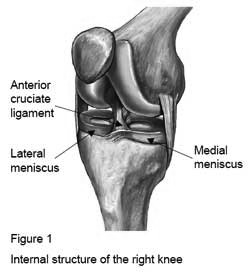The anterior cruciate ligament (ACL) is one of the important ligaments that stabilise your knee joint (see below). If you have torn (ruptured) this ligament, the knee can collapse or ‘give way’ when making twisting or turning movements.
An ACL rupture happens as a result of a twisting injury to the knee. The common causes are football and skiing injuries. You can injure other parts of your knee at the same time, such as tearing a cartilage or damaging the joint surface.
If your ACL reconstruction surgery is successful, your knee should not give way any more. This will allow you to be more active and return to some or all of your sporting activities.

Your physiotherapist can give you exercises to strengthen and improve the co-ordination of the muscles in your thigh. This can often stop your knee giving way during everyday activities. Wearing a knee brace can sometimes help during sports activities.
A variety of anaesthetic techniques are possible. The ACL reconstruction surgery usually takes between an hour and an hour and a half.
Your surgeon will make one or more cuts on the front and sides of your knee. The operation will be performed by arthroscopy (‘keyhole’ surgery) using a camera to see inside the knee.
Your surgeon will replace the ACL with a piece of suitable tissue (a graft) from elsewhere in the body – usually hamstrings. The top and bottom ends of the replacement ligament are fixed with special screws or anchors into ‘tunnels’ drilled in the bone.
You should be able to go home the same day or the day after.Your surgeon may want you to wear a knee brace for a few weeks after the ACL reconstruction surgery. Once your knee is settling down you will need to start intensive physiotherapy treatment which may continue for as long as six months.Regular exercise should help you to return to normal activities as soon as possible. Before you start exercising, you should ask a member of the healthcare team or your GP for advice. It is unlikely that your knee will ever be quite as good as it was before the original injury.
If your knee continually gives way after an ACL rupture, ACL reconstruction surgery offers the chance of improving the stability of your knee in everyday life and in sporting activities. You may be able to return to a level of sport that otherwise would not be possible.